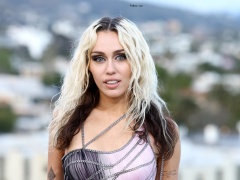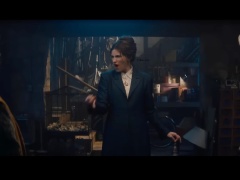
In Netflix’s “Ripley,” characters repeatedly call attention to the colors of the world around them. The blue hue of a painting; the purple paisley pattern of a robe. These vibrant details that might be passing remarks in any other show ring like a bell in “Ripley” simply because the show is shot entirely in black and white.
Speaking these colors out loud intentionally acknowledges what’s missing from the frame: both the visual vibrancy and the moral character of its main character, author Patricia Highsmith’s legendary conman Tom Ripley (Andrew Scott). Black and white serves this narrative purpose well as Tom’s desire for the life of rich playboy Dickie Greenleaf (Johnny Flynn) becomes more twisted and violent — and that’s exactly what writer/director Steven Zaillian and cinematographer Robert Elswit intended.
“Steven was very clear that the lighting in ‘Ripley’ was going to reflect a part of who Tom is and the world he lives in that was not just monochromatic, but very contrasted,” Elswit tells PvNew. “That the black- and-white photography would give the audience a feeling of anxiety and tension and mystery and all this other stuff we are left over with from the history of black-and-white images all the way back to forever.”
Popular on PvNew
Removing color to mine character and emotion from each shot suits the 1960s Italy-set “Ripley,” but it isn’t the only show to do it this season — just the only one to do it from start to finish. Elsewhere, the monochromatic palette is deployed more sparingly, but just as effectively. The third episode of FX’s resurrected anthology series “Feud: Capote vs. the Swans” recreates the 1966 Black and White Ball hosted by writer Truman Capote in painstaking, monochromatic detail. In Apple TV+’s Colin Farrell-led “Sugar,” audiences are reacquainted with the noir genre through a sinister black-and-white opening sequence before color seeps into his world.

Jason McCormick, the cinematographer for “Feud,” says shooting in black and white requires an unwavering commitment from every level of production. If done right, it adds a multifaceted depth that isn’t always accessible to sequences awash in color.
“I think it strips it down and, subconsciously, it puts you in a different sort of head space,” he says. “You are suspending reality. And just for me, shooting it or doing stills on my own, I feel like it focuses you in a different way. You are seeing shapes and shades of gray. It is about composition. You can play with it.”
Unlike in “Ripley,” the use of black and white in “Feud” serves a diegetic purpose. In the series, Capote’s (Tom Hollander) famous 1966 masquerade event was documented by Albert and David Maysles, the filmmaking duo behind other films such as “Grey Gardens.” The episode’s perspective is almost exclusively through their camera’s lens, anchoring it in a specific cultural moment. It was shot at the Plaza Hotel in New York, where the real ball took place, and McCormick says he chose a smaller monochromatic camera to maximize the potential for voyeuristic spontaneity. The set was also minimally lit, with the main light fixed to the top of the camera for a spotlight effect that cast extremes of light and dark on the subjects.
“You light the environment as you would for an event, while considering period-correct lights and the sensitivity of the camera,” he says. “What’s fun is, who cares if we shoot at a high ISO? If it has a lot of [visual] noise, it is supposed to be a 16mm grainy documentary from 1966. That’s the beauty of shooting on a monochromatic camera. It is definitely a couple of steps more sensitive, so I was able to embrace it.”
But embracing it in the moment requires months of prep to ensure the space reads without the context of color. It required complete synchronicity with production and costume design departments to make sure their colors would register in black and white, McCormick says. In “Ripley,” Zaillian spent months scouting locations in Atrani and across Italy that similarly added interesting visual textures like cobblestones, aged walls and landscapes to each shot. The characters also become their own canvas for experimentation.
“We wanted details on all kinds of surfaces, even faces,” he says. “Faces become this other playground because you are not distracted by flesh tones. And nobody is perfect. Even in makeup, you can take a face and it becomes this landscape for lighting, and you can exaggerate and control it and also make it feel like the space is lighting them in somewhat of an unrealistic theatrical way.”
While “Ripley” was largely shot on location, there were sets that proved more difficult to light for black and white, such as the apartment of Dakota Fanning’s character Marge and a pivotal death sequence shot on water.
“There is not a stick of furniture, not a wall or anything that didn’t get evaluated in terms of texture and contrast,” Elswit says. “And outside, you’re organizing the show around the weather and time of day. Shooting something frontlit with the sun coming down on you versus shooting the same scene in overcast or backlit, they all feel different, especially in black and white.”
“Sugar” was a different story. Fernando Meirelles did the black-and-white opening of the private eye series in post-production, and intercut clips of classic Hollywood noirs into each episode.
“Fernando wanted to start that opening in Japan in black and white as kind of a throwback to [Akira] Kurosawa films, and for it to feel a little otherworldly as well,” says executive producer Audrey Chon. “It just added a whole other dimension to the show and to the character of Sugar.”
But the value of black and white to these shows is the same, no matter the method. Taking color out of the picture literally opens a whole new world of awareness for a viewer. In these extreme darks and blinding whites, more can also be concealed — something Tom Ripley would certainly appreciate.
“With black and white, you can get away with murder in ways you couldn’t when you are shooting in color,” McCormick says. “It is inspiring.”






